
Frans Hals Painting Reproductions 1 of 1
c.1582-1666
Dutch Baroque Painter
Frans Hals (c. 1580 – August 26, 1666) was a Dutch painter during the Dutch Golden Age. As a portrait painter, considered by some as second only to Rembrandt, in Holland, he displayed extraordinary talent and quickness in his art.
Biography
Hals was born in 1580 or 1581, in Antwerp. In 1585, after Antwerp fell to Spain in the Eighty Years War his family moved to Haarlem in the Northern Low Countries, where he lived the remainder of his life. It wasn't until he was 27 that Hals became a member of the Sint-Lucasgilde (St. Lucas Guild).
He took painting lessons from Flemish painter Karel van Mander (1548–1606), who had also fled from the Spaniards, but Mander's ideas are not visible in Hals' work. The earliest known of Hals' art is the 1611, Jacobus Zaffius. His 'breakthrough' came in 1616, with the life-size group portrait, The Banquet of the Officers of the St George Militia Company.
Historians have reported that he mistreated his first wife, Anneke Hermansz (Annetje Harmensdochter Abeel), and she died in 1616. Already with two children by Anneke, he married Lysbeth Reyniers in 1617, and they had eight children. He reportedly liked to drink, which led him into the company of people of ill repute.
Although Hals' work was in demand throughout his life, he experienced financial difficulties. In addition to painting, he worked as an art dealer and restorer. His creditors took him to court several times, and to settle his debt with a baker in 1652 he sold his belongings. The inventory of the property seized mentions only three mattresses and bolsters, an armoire, a table and five pictures. Left destitute, the municipality gave him an annuity of 200 forms in 1664.
At a time when the Dutch nation fought for independence, Hals appeared in the ranks of its military guilds. He was also a member of the Chamber of Rhetoric, and in 1644 chairman of the Painters Corporation at Haarlem.
Frans Hals died in Haarlem in 1666 and was buried in the city's St. Bavo Church. His widow later died obscurely in a hospital after seeking outdoor relief from the guardians of the poor.
Artistic career
Hals is best known for his portraits, mainly of wealthy citizens. He also painted large group portraits, many of which showed civil guards. He was a Baroque painter, with intimate realism and a radical approach.
His pictures illustrate the various strata of society into which his life led him - banquets or meetings of officers, sharpshooters, guildsmen, admirals, generals, burgomasters, merchants, lawyers, and clerks, itinerant players and singers, gentlefolk, fishwives and tavern heroes.
In group portraits, such as the Archers of St. Hadrian, Hals captures each character in a different manner. The faces are not idealized and are clearly distinguishable with their personalities revealed in a variety of poses and facial expressions.
His first master at Antwerp was probably Van Noort but he then entered the atelier of painter and historian Carel van Mander. (Hals owned some Mander paintings, that were amongst the items sold to pay his bakery debt in 1652). He soon improved upon the practice of the time, illustrated by Jan van Scorel and Antonio Moro, and gradually emancipated himself from tradition.
Hals was fond of daylight and silvery sheen, while Rembrandt used golden glow effects based upon artificial contrasts of low light in immeasurable gloom. Both men were painters of touch, but of touch on different keys - Rembrandt was the bass, Hals the treble. Hals seized, with rare intuition, a moment in the life of his subjects. What nature displayed in that moment he reproduced thoroughly in a delicate scale of color, and with mastery over every form of expression. He became so clever that exact tone, light and shade, and modelling were obtained with a few marked and fluid strokes of the brush.
The only record of his work in the first decade of his independent activity is an engraving by Jan van de Velde copied from lost portrait of The Minister Johannes Bogardus.
The earliest works by Hals that remain, Two Boys Playing and Singing and a Banquet of the Officers of the St Joris Doele or Arquebusiers of St George (1616), show him as a careful draughtsman capable of great finish, yet spirited withal. The flesh he painted, is pastose and burnished, less clear than it subsequently became. Later, he became more effective, displayed more freedom of hand, and a greater command of effect.
During this period he painted the full-length portrait of Madame van Beresteyn (Louvre), and a full-length portrait of Willem van Heythuysen leaning on a sword. Both these pictures are equalled by the other Banquet of the officers, of the Arquebusiers of St George (with different portraits) and the Banquet of the officers of the Cloveniers or Arquebusiers of St Andrew of 1627 and an Assembly of the officers of the Arquebusiers of St Andrew of 1633. A similar painting, with the date of 1637, suggests some study of Rembrandt masterpieces, and a similar influence is apparent in a picture of 1641 representing the Regents of the Company of St Elizabeth, and in the portrait of Maria Voogt at Amsterdam.
From 1620 till 1640 he painted many double portraits of married couples, on separate panels, the man on the left panel, his wife at his right. Only once did Hals portray a couple on a single canvas: Double Portrait of a Couple, (circa 1623, Rijksmuseum Amsterdam).
His style changed throughout his life. Vivid colours were gradually replaced by pieces where one colour dominated. After 1641 he showed a tendency to restrict the gamut of his palette, and to suggest color rather than express it. Later in his life darker tones, even with much black, took over. His brush strokes became looser in later years, fine details became less important than an overall impression. Also where his earlier pieces radiated gaiety and liveliness, his later portraits emphasized the stature and dignity of the people portrayed. This austerity is displayed in Regentesses of the Old Men's Alms House and The Regents and Regentesses of the Oudemannenhuis (c. 1664), which are masterpieces of color, though in substance all but monochromes. His restricted palette is particularly noticeable in his flesh tints which from year to year became more grey, until finally the shadows were painted in almost absolute black, as in the Tymane Oosdorp.
As this tendency coincides with the period of his poverty, historians suggest that one of the reasons, if not the only reason, of his predilection for black and white pigment was the low price of these colors as compared with the costly lakes and carmines.
As a portrait painter Hals had scarcely the psychological insight of a Rembrandt or Velazquez, though in a few works, like the Admiral de Ruyter, the Jacob Olycan, and the Albert van der Meer paintings, he reveals a searching analysis of character which has little in common with the instantaneous expression of his so-called character portraits. In these, he generally sets upon the canvas the fleeting aspect of the various stages of merriment, from the subtle, half ironic smile that quivers round the lips of the curiously misnamed Laughing Cavalier to the imbecile grin of the Hille Bobbe. To this group of pictures belong Baron Gustav Rothschilds Jester, the Bohemienne and the Fisher Boy, whilst the Portrait of the Artist with his second Wife, and the somewhat confused group of the Beresteyn Family at the Louvre show a similar tendency. Far less scattered in arrangement than this Beresteyn group, and in every respect one of the most masterly of Hals' achievements is the group called The Painter and his Family, which was almost unknown until it appeared at the winter exhibition at the Royal Academy in 1906.
Many of Hals' works have disappeared, but it is not known how many. According to the most authoritative present day catalogue, compiled by Seymour Slive in 1970-1974 (Slive's last great Hals exhibition catalogue followed in 1989), another 222 paintings can be ascribed to Hals. Another authority on Hals, Claus Grimm, believes this number to be lower (145) in his Frans Hals. Das Gesamtwerk (1989).
It is not known whether Hals ever painted landscapes, still lifes or narrative pieces, but it is unlikely. Many artists in the 17th century in Holland opted to specialise, and Hals also appears to have been a pure portrait specialist.
Painting technique
People often think that Hals 'threw' his works on 'in one toss' (aus einem Guss) onto the canvas. Research of a technical and scientific nature has clarified that this impression is not correct. True, the odd work was largely put down without underdrawings or underpainting ('alla prima'), but most of the works were created in various layers, as was customary at that time. Sometimes a drawing was made with chalk or paint on top of a grey or pink undercoat, and was then more or less filled in, in stages. It does seem that Hals usually applied his underpainting very loosely: he was a virtuoso from the beginning. This applies, of course, particularly to his somewhat later, mature works.
Hals displayed tremendous daring, great courage and virtuosity, and had a great capacity to pull back his hands from the canvas, or panel, as soon as the person portrayed was on it. He didn't 'paint them to death', as many of his contemporaries did, in their great accuracy and diligence whether requested by their clients or not.
'An unusual manner of painting, all his own, surpassing almost everyone,' ('Een onghemeyne [ongewone] manier van schilderen, die hem eyghen is, by nae alle [iedereen] over-treft'), wrote his first biographer, Schrevelius, in the 17th century on Hals' painting methods. For that matter, schematic painting was not Hals' own idea (the approach already existed in 16th century Italy), and Hals was probably inspired by Flemish contemporaries, Rubens and Van Dyck, in his painting method.
As early as the 17th century, people were struck by the vitality of Frans Hals' portraits. For example, Haarlem resident Theodorus Schrevelius noted that Hals' works reflected 'such power and life' that the painter 'seems to challenge nature with his brush'. Centuries later Vincent van Gogh wrote to his brother Theo: 'What a joy it is to see a Frans Hals, how different it is from the paintings - so many of them - where everything is carefully smoothed out in the same manner.' Hals chose not to give a smooth finish to his painting, as most of his contemporaries did, but mimiced the vitality of his subject by using smears, lines, spots, lines, spots, large patches of colour and hardly any details.
It was not until the 19th century that his technique had followers, particularly among the Impressionists. Pieces such as The Regentesses of the Old Men's Alms House and the civic guard paintings demonstrate this technique to the fullest.
Biography
Hals was born in 1580 or 1581, in Antwerp. In 1585, after Antwerp fell to Spain in the Eighty Years War his family moved to Haarlem in the Northern Low Countries, where he lived the remainder of his life. It wasn't until he was 27 that Hals became a member of the Sint-Lucasgilde (St. Lucas Guild).
He took painting lessons from Flemish painter Karel van Mander (1548–1606), who had also fled from the Spaniards, but Mander's ideas are not visible in Hals' work. The earliest known of Hals' art is the 1611, Jacobus Zaffius. His 'breakthrough' came in 1616, with the life-size group portrait, The Banquet of the Officers of the St George Militia Company.
Historians have reported that he mistreated his first wife, Anneke Hermansz (Annetje Harmensdochter Abeel), and she died in 1616. Already with two children by Anneke, he married Lysbeth Reyniers in 1617, and they had eight children. He reportedly liked to drink, which led him into the company of people of ill repute.
Although Hals' work was in demand throughout his life, he experienced financial difficulties. In addition to painting, he worked as an art dealer and restorer. His creditors took him to court several times, and to settle his debt with a baker in 1652 he sold his belongings. The inventory of the property seized mentions only three mattresses and bolsters, an armoire, a table and five pictures. Left destitute, the municipality gave him an annuity of 200 forms in 1664.
At a time when the Dutch nation fought for independence, Hals appeared in the ranks of its military guilds. He was also a member of the Chamber of Rhetoric, and in 1644 chairman of the Painters Corporation at Haarlem.
Frans Hals died in Haarlem in 1666 and was buried in the city's St. Bavo Church. His widow later died obscurely in a hospital after seeking outdoor relief from the guardians of the poor.
Artistic career
Hals is best known for his portraits, mainly of wealthy citizens. He also painted large group portraits, many of which showed civil guards. He was a Baroque painter, with intimate realism and a radical approach.
His pictures illustrate the various strata of society into which his life led him - banquets or meetings of officers, sharpshooters, guildsmen, admirals, generals, burgomasters, merchants, lawyers, and clerks, itinerant players and singers, gentlefolk, fishwives and tavern heroes.
In group portraits, such as the Archers of St. Hadrian, Hals captures each character in a different manner. The faces are not idealized and are clearly distinguishable with their personalities revealed in a variety of poses and facial expressions.
His first master at Antwerp was probably Van Noort but he then entered the atelier of painter and historian Carel van Mander. (Hals owned some Mander paintings, that were amongst the items sold to pay his bakery debt in 1652). He soon improved upon the practice of the time, illustrated by Jan van Scorel and Antonio Moro, and gradually emancipated himself from tradition.
Hals was fond of daylight and silvery sheen, while Rembrandt used golden glow effects based upon artificial contrasts of low light in immeasurable gloom. Both men were painters of touch, but of touch on different keys - Rembrandt was the bass, Hals the treble. Hals seized, with rare intuition, a moment in the life of his subjects. What nature displayed in that moment he reproduced thoroughly in a delicate scale of color, and with mastery over every form of expression. He became so clever that exact tone, light and shade, and modelling were obtained with a few marked and fluid strokes of the brush.
The only record of his work in the first decade of his independent activity is an engraving by Jan van de Velde copied from lost portrait of The Minister Johannes Bogardus.
The earliest works by Hals that remain, Two Boys Playing and Singing and a Banquet of the Officers of the St Joris Doele or Arquebusiers of St George (1616), show him as a careful draughtsman capable of great finish, yet spirited withal. The flesh he painted, is pastose and burnished, less clear than it subsequently became. Later, he became more effective, displayed more freedom of hand, and a greater command of effect.
During this period he painted the full-length portrait of Madame van Beresteyn (Louvre), and a full-length portrait of Willem van Heythuysen leaning on a sword. Both these pictures are equalled by the other Banquet of the officers, of the Arquebusiers of St George (with different portraits) and the Banquet of the officers of the Cloveniers or Arquebusiers of St Andrew of 1627 and an Assembly of the officers of the Arquebusiers of St Andrew of 1633. A similar painting, with the date of 1637, suggests some study of Rembrandt masterpieces, and a similar influence is apparent in a picture of 1641 representing the Regents of the Company of St Elizabeth, and in the portrait of Maria Voogt at Amsterdam.
From 1620 till 1640 he painted many double portraits of married couples, on separate panels, the man on the left panel, his wife at his right. Only once did Hals portray a couple on a single canvas: Double Portrait of a Couple, (circa 1623, Rijksmuseum Amsterdam).
His style changed throughout his life. Vivid colours were gradually replaced by pieces where one colour dominated. After 1641 he showed a tendency to restrict the gamut of his palette, and to suggest color rather than express it. Later in his life darker tones, even with much black, took over. His brush strokes became looser in later years, fine details became less important than an overall impression. Also where his earlier pieces radiated gaiety and liveliness, his later portraits emphasized the stature and dignity of the people portrayed. This austerity is displayed in Regentesses of the Old Men's Alms House and The Regents and Regentesses of the Oudemannenhuis (c. 1664), which are masterpieces of color, though in substance all but monochromes. His restricted palette is particularly noticeable in his flesh tints which from year to year became more grey, until finally the shadows were painted in almost absolute black, as in the Tymane Oosdorp.
As this tendency coincides with the period of his poverty, historians suggest that one of the reasons, if not the only reason, of his predilection for black and white pigment was the low price of these colors as compared with the costly lakes and carmines.
As a portrait painter Hals had scarcely the psychological insight of a Rembrandt or Velazquez, though in a few works, like the Admiral de Ruyter, the Jacob Olycan, and the Albert van der Meer paintings, he reveals a searching analysis of character which has little in common with the instantaneous expression of his so-called character portraits. In these, he generally sets upon the canvas the fleeting aspect of the various stages of merriment, from the subtle, half ironic smile that quivers round the lips of the curiously misnamed Laughing Cavalier to the imbecile grin of the Hille Bobbe. To this group of pictures belong Baron Gustav Rothschilds Jester, the Bohemienne and the Fisher Boy, whilst the Portrait of the Artist with his second Wife, and the somewhat confused group of the Beresteyn Family at the Louvre show a similar tendency. Far less scattered in arrangement than this Beresteyn group, and in every respect one of the most masterly of Hals' achievements is the group called The Painter and his Family, which was almost unknown until it appeared at the winter exhibition at the Royal Academy in 1906.
Many of Hals' works have disappeared, but it is not known how many. According to the most authoritative present day catalogue, compiled by Seymour Slive in 1970-1974 (Slive's last great Hals exhibition catalogue followed in 1989), another 222 paintings can be ascribed to Hals. Another authority on Hals, Claus Grimm, believes this number to be lower (145) in his Frans Hals. Das Gesamtwerk (1989).
It is not known whether Hals ever painted landscapes, still lifes or narrative pieces, but it is unlikely. Many artists in the 17th century in Holland opted to specialise, and Hals also appears to have been a pure portrait specialist.
Painting technique
People often think that Hals 'threw' his works on 'in one toss' (aus einem Guss) onto the canvas. Research of a technical and scientific nature has clarified that this impression is not correct. True, the odd work was largely put down without underdrawings or underpainting ('alla prima'), but most of the works were created in various layers, as was customary at that time. Sometimes a drawing was made with chalk or paint on top of a grey or pink undercoat, and was then more or less filled in, in stages. It does seem that Hals usually applied his underpainting very loosely: he was a virtuoso from the beginning. This applies, of course, particularly to his somewhat later, mature works.
Hals displayed tremendous daring, great courage and virtuosity, and had a great capacity to pull back his hands from the canvas, or panel, as soon as the person portrayed was on it. He didn't 'paint them to death', as many of his contemporaries did, in their great accuracy and diligence whether requested by their clients or not.
'An unusual manner of painting, all his own, surpassing almost everyone,' ('Een onghemeyne [ongewone] manier van schilderen, die hem eyghen is, by nae alle [iedereen] over-treft'), wrote his first biographer, Schrevelius, in the 17th century on Hals' painting methods. For that matter, schematic painting was not Hals' own idea (the approach already existed in 16th century Italy), and Hals was probably inspired by Flemish contemporaries, Rubens and Van Dyck, in his painting method.
As early as the 17th century, people were struck by the vitality of Frans Hals' portraits. For example, Haarlem resident Theodorus Schrevelius noted that Hals' works reflected 'such power and life' that the painter 'seems to challenge nature with his brush'. Centuries later Vincent van Gogh wrote to his brother Theo: 'What a joy it is to see a Frans Hals, how different it is from the paintings - so many of them - where everything is carefully smoothed out in the same manner.' Hals chose not to give a smooth finish to his painting, as most of his contemporaries did, but mimiced the vitality of his subject by using smears, lines, spots, lines, spots, large patches of colour and hardly any details.
It was not until the 19th century that his technique had followers, particularly among the Impressionists. Pieces such as The Regentesses of the Old Men's Alms House and the civic guard paintings demonstrate this technique to the fullest.
19 Frans Hals Paintings
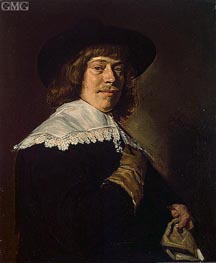
Portrait of a Young Man Holding a Glove c.1650
Oil Painting
$1445
$1445
Canvas Print
$68.79
$68.79
SKU: HAF-3252
Frans Hals
Original Size: 80 x 66.5 cm
The State Hermitage Museum, St. Petersburg, Russia
Frans Hals
Original Size: 80 x 66.5 cm
The State Hermitage Museum, St. Petersburg, Russia
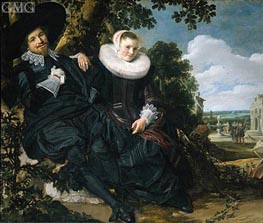
Married Couple in a Garden c.1622
Oil Painting
$6916
$6916
Canvas Print
$69.99
$69.99
SKU: HAF-3253
Frans Hals
Original Size: 140 x 166.5 cm
Rijksmuseum, Amsterdam, Netherlands
Frans Hals
Original Size: 140 x 166.5 cm
Rijksmuseum, Amsterdam, Netherlands
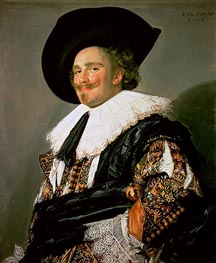
The Laughing Cavalier 1624
Oil Painting
$1786
$1786
Canvas Print
$67.73
$67.73
SKU: HAF-3254
Frans Hals
Original Size: 83 x 67 cm
The Wallace Collection, London, UK
Frans Hals
Original Size: 83 x 67 cm
The Wallace Collection, London, UK
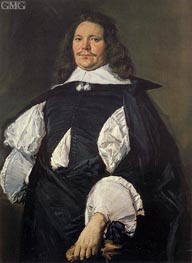
Portrait of a Man c.1660
Oil Painting
$1740
$1740
Canvas Print
$59.75
$59.75
SKU: HAF-3255
Frans Hals
Original Size: 113 x 82 cm
Frick Collection, New York, USA
Frans Hals
Original Size: 113 x 82 cm
Frick Collection, New York, USA
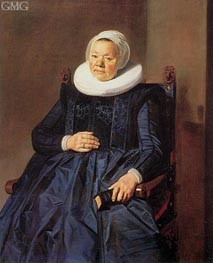
Portrait of a Woman 1635
Oil Painting
$1838
$1838
Canvas Print
$66.53
$66.53
SKU: HAF-3256
Frans Hals
Original Size: 116.5 x 93.3 cm
Frick Collection, New York, USA
Frans Hals
Original Size: 116.5 x 93.3 cm
Frick Collection, New York, USA
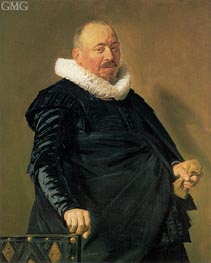
Portrait of an Elderly Man c.1627/30
Oil Painting
$1786
$1786
Canvas Print
$65.77
$65.77
SKU: HAF-3257
Frans Hals
Original Size: 115.6 x 91.4 cm
Frick Collection, New York, USA
Frans Hals
Original Size: 115.6 x 91.4 cm
Frick Collection, New York, USA

Portrait of a Man, Possibly Nicolaes Hasselaer c.1630/35
Oil Painting
$1327
$1327
Canvas Print
$69.83
$69.83
SKU: HAF-3258
Frans Hals
Original Size: 79.5 x 66.5 cm
Rijksmuseum, Amsterdam, Netherlands
Frans Hals
Original Size: 79.5 x 66.5 cm
Rijksmuseum, Amsterdam, Netherlands

Portrait of a Woman (Sara Wolphaerts van Diemen) c.1630/35
Oil Painting
$1564
$1564
Canvas Print
$66.68
$66.68
SKU: HAF-3259
Frans Hals
Original Size: 79.5 x 66.5 cm
Rijksmuseum, Amsterdam, Netherlands
Frans Hals
Original Size: 79.5 x 66.5 cm
Rijksmuseum, Amsterdam, Netherlands
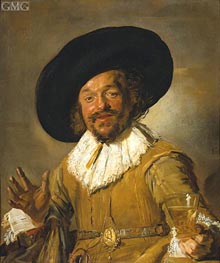
The Merry Drinker c.1628/30
Oil Painting
$1500
$1500
Canvas Print
$70.44
$70.44
SKU: HAF-3260
Frans Hals
Original Size: 81 x 66.5 cm
Rijksmuseum, Amsterdam, Netherlands
Frans Hals
Original Size: 81 x 66.5 cm
Rijksmuseum, Amsterdam, Netherlands
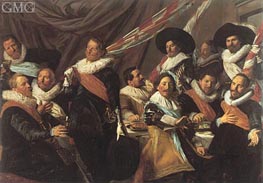
Banquet of the Officers of the St George Militia 1627
Oil Painting
$5670
$5670
Canvas Print
$56.89
$56.89
SKU: HAF-3261
Frans Hals
Original Size: 179 x 257.5 cm
Frans Hals Museum, Haarlem, Netherlands
Frans Hals
Original Size: 179 x 257.5 cm
Frans Hals Museum, Haarlem, Netherlands
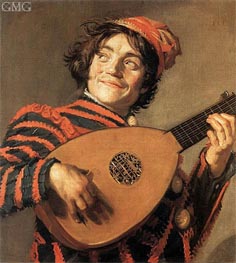
Buffoon Playing a Lute c.1623
Oil Painting
$1470
$1470
Canvas Print
$73.44
$73.44
SKU: HAF-3262
Frans Hals
Original Size: 67 x 60 cm
Louvre Museum, Paris, France
Frans Hals
Original Size: 67 x 60 cm
Louvre Museum, Paris, France

Singing Boy with a Flute c.1623/25
Oil Painting
$1327
$1327
Canvas Print
$66.37
$66.37
SKU: HAF-3263
Frans Hals
Original Size: 68.8 x 55.2 cm
Gemaldegalerie, Berlin, Germany
Frans Hals
Original Size: 68.8 x 55.2 cm
Gemaldegalerie, Berlin, Germany
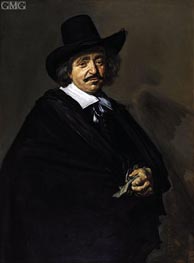
Portrait of a Man c.1650/52
Oil Painting
$1877
$1877
Canvas Print
$60.81
$60.81
SKU: HAF-4254
Frans Hals
Original Size: 108 x 79.5 cm
Liechtenstein Museum, Vienna, Austria
Frans Hals
Original Size: 108 x 79.5 cm
Liechtenstein Museum, Vienna, Austria
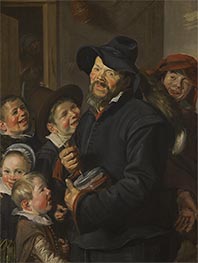
The Rommel-Pot Player c.1618/22
Oil Painting
$2415
$2415
Canvas Print
$62.16
$62.16
SKU: HAF-17705
Frans Hals
Original Size: 106 x 80.3 cm
Kimbell Art Museum, Fort Worth, USA
Frans Hals
Original Size: 106 x 80.3 cm
Kimbell Art Museum, Fort Worth, USA
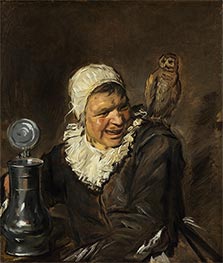
Malle Babbe c.1633/35
Oil Painting
$1074
$1074
Canvas Print
$70.14
$70.14
SKU: HAF-18819
Frans Hals
Original Size: 78.5 x 66.2 cm
Gemaldegalerie, Berlin, Germany
Frans Hals
Original Size: 78.5 x 66.2 cm
Gemaldegalerie, Berlin, Germany

Catharina Hooft with Her Wet Nurse c.1619/20
Oil Painting
$2671
$2671
Canvas Print
$61.41
$61.41
SKU: HAF-18820
Frans Hals
Original Size: 91.8 x 68.3 cm
Gemaldegalerie, Berlin, Germany
Frans Hals
Original Size: 91.8 x 68.3 cm
Gemaldegalerie, Berlin, Germany
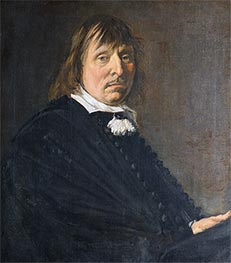
Tyman Oosdorp 1656
Oil Painting
$1011
$1011
Canvas Print
$72.55
$72.55
SKU: HAF-18821
Frans Hals
Original Size: 82 x 73.5 cm
Gemaldegalerie, Berlin, Germany
Frans Hals
Original Size: 82 x 73.5 cm
Gemaldegalerie, Berlin, Germany
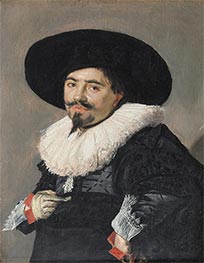
Portrait of a Man 1625
Oil Painting
$662
$662
Canvas Print
$54.62
$54.62
SKU: HAF-18822
Frans Hals
Original Size: 26.3 x 20.7 cm
Gemaldegalerie, Berlin, Germany
Frans Hals
Original Size: 26.3 x 20.7 cm
Gemaldegalerie, Berlin, Germany
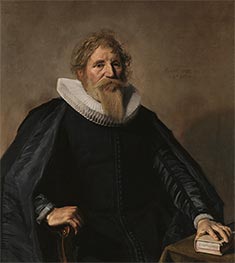
Portrait of a Man 1633
Oil Painting
$1501
$1501
Canvas Print
$73.90
$73.90
SKU: HAF-18980
Frans Hals
Original Size: 103 x 89 cm
Fuji Art Museum, Tokyo, Japan
Frans Hals
Original Size: 103 x 89 cm
Fuji Art Museum, Tokyo, Japan